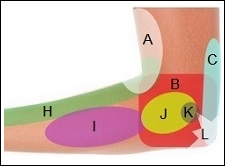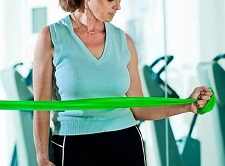- Home
- Common Shoulder Problems
- Triceps Tendonitis
Triceps Tendonitis
Written By: Chloe Wilson BSc (Hons) Physiotherapy
Reviewed By: SPE Medical Review Board
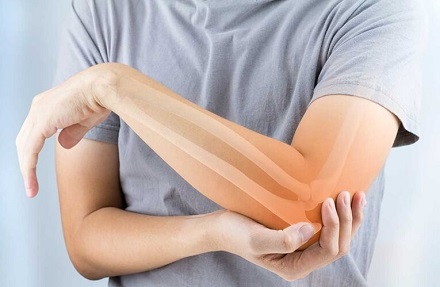
Triceps tendonitis develops due to inflammation in the tendon that attaches the triceps muscle to the back of the elbow, causing pain in the elbow and upper arm.
Also known as "triceps tendinitis", "triceps tendinopathy" or "Weightlifters Elbow", triceps tendonitis is actually one of the least common types of arm tendonitis, much less prevalent that biceps tendonitis for example.
Typically caused by overuse activities from repetitive elbow extension, triceps tendonitis results in pain, swelling and tenderness around the elbow.
Here we look at the common causes and risk factors, typically symptoms, how it is diagnosed and the best triceps tendonitis treatment options to ensure a full recovery from Weightlifters elbow.
Triceps Brachii Anatomy
Triceps brachii, more commonly referred to as just “triceps” is a three-headed muscle, arising from three points at the shoulder:
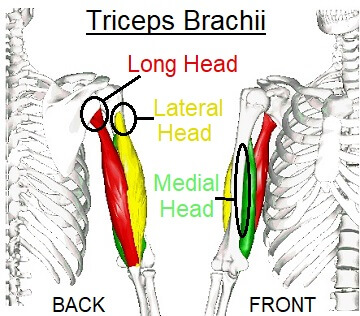
- Long Head: back of the shoulder blade just below the shoulder socket
- Lateral Head: back of the upper arm, just above the radial groove
- Medial Head: long attachment area from just below the radial groove, extending down almost the full length of the back of the upper arm
The three heads of triceps brachii extend down the back of the upper arm forming the triceps tendon, a tough, flexible band of connective tissue that attaches just below the elbow to the back of the olecranon process.
Triceps brachii is the only muscle found on the back of the upper arm. The main function of triceps brachii is to extend the elbow but it also helps to extend and adduct the upper arm as well as contributing to shoulder stability.
What Is Triceps Tendonitis?
Triceps tendonitis develops when there is repetitive strain through the tendon causing damage, irritation and/or tearing in the triceps tendon. This leads to tendon degeneration and inflammation which results in pain at the back of the elbow.
Triceps Tendonitis can develop in three places:
- Musculotendinous Junction: where muscle bellies of triceps converge to form the triceps tendon
- Osseotendinous Junction: where the tendon attaches to the bone just below the elbow
- Triceps Tendon: within the tendon itself
Pain from triceps tendonitis is usually fairly localized and the affected area may be tender to touch. Triceps tendonitis is one of the most common causes of pain behind the elbow.
What Causes Tricep Tendonitis?
Anything that places repetitive strain through the triceps brachii tendon can result in tricep tendonitis. The most common causes of triceps tendonitis are:
1. Repetitive Overuse
Activities that repeatedly extend or hyperextend (overextend) the arm are the most common cause of triceps tendonitis. Common examples include:
- Sports e.g. gymnastics, weightlifting & boxing
- DIY e.g. hammering
- Throwing activities e.g. baseball
- Quick elbow extension e.g. mountain biking and off-road motor cycling
- Workout exercises e.g. press ups
Overuse is the most common cause of triceps tendonitis.
2. Injury
Sudden overloading of the triceps tendon e.g. lifting a heavy weight or a direct blow to the back of the elbow e.g. traffic accident can also result in weightlifters elbow. Microscopic tears develop in the tendon and if they fail to heal problem can cause ongoing inflammation and weakening in the tendon.
3. Risk Factors
There are a few risk factors that can lead to increased risk of developing triceps tendonitis which include:
- Muscle Weakness
- Triceps Tightness: and lack of flexibility
- Previous Injuries: e.g. Elbow Dislocation
- Not Warming Up: before sports
- Workout Errors: poor technique or overtraining
- Steroid Use: long-term or heavy use
- Certain Medical Conditions: e.g. diabetes and rheumatoid arthritis
Triceps Tendonitis Symptoms
Weightlifters elbow tends to cause pain in the elbow, arm or shoulder that gets worse when using the triceps brachii muscle.
Typical triceps tendonitis symptoms include:
- Pain: most typically an aching at the back of the elbow, but may also be felt in the back of the upper arm and/or shoulder
- Tenderness: over the back of the elbow
- Worse With Activity: pain gets worse when using or stretching your triceps e.g. pushing, pulling, throwing, carrying
- Snapping/Popping Noise: when moving your arm or at the time of injury
- Weakness: in your upper arm
- Swelling: at the back of the elbow
- Stiffness: reduced range of motion in your arm
Diagnosing Triceps Tendonitis
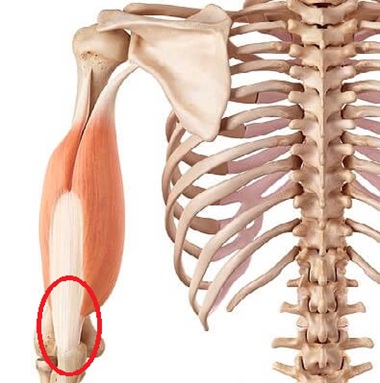
Usually, triceps tendonitis can be diagnosed by your doctor or physical therapist. They carry out a full subjective assessment where they ask you questions about your symptoms, when they started, aggravating and easing factors etc.
They will then perform a thorough objective assessment where they examine you looking at muscle strength and length in the shoulder and elbow, palpate the painful area, get you to perform various movements and they will perform various tests to rule out other potential problems.
A thorough subjective and objective assessment is usually sufficient to diagnose triceps tendonitis but if there is any doubt or they suspect there may be something else going on such as arthritis, they may send you for imaging such as an MRI or ultrasound scan.
Another common cause of posterior elbow pain is olecranon bursitis, inflammation of the small fluid-filled sac that sits over the pointy bone at the elbow. If there is a pocket of swelling behind the elbow it is more likely to be olecranon brusitis than triceps tendonitis. If you need help working out what is causing your pain visit the elbow pain diagnosis section.
Treatment For Triceps Tendonitis
Triceps tendonitis treatment aims to reduce pain and inflammation and prevent further injury. Mild cases will usually settle quickly with a combination of rest, ice and pain relief but if symptoms continue for more than a couple of weeks the further treatment will be necessary.
#CommissionsEarned from Amazon on qualifying purchases
The best treatments for triceps tendonitis are:
1. Rest
It is really important to avoid any activities that aggravate symptoms with triceps tendonitis to give the tendon time to heal. Failure to do so will lead to more inflammation and damage in the tendon which will lead to more pain and slower healing. You can still use your arm but should avoid activities such as pushing, pulling, throwing and sports.
In severe cases of triceps tendonitis you may be advised to wear a resting elbow splint but these are mostly used following surgery.
2. Ice
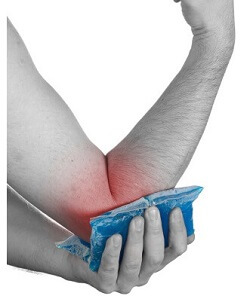
Regularly applying ice to the painful area of your triceps brachii helps not only to reduce the pain from triceps tendonitis but more important helps to reduce the inflammation in the tendon. This helps speed up healing.
But it is important to use ice correctly. Not using it enough will reduce its effectiveness, using it too much can actually make the inflammation worse!
The best way to use ice for triceps tendonitis, and any other injury, is to use an ice pack for 10-15 minutes at a time. You should then wait at least 2 hours before reapplying it. Aim, for at least 4 applications each day.
Ice works by causing vasoconstriction – narrowing of the blood vessels to reduce the amount of inflammation. But if you use ice for too long, the blood vessels actually dilate – open up more, which causes extra blood, fluid and inflammatory chemicals to rush to the damaged tendon causing further inflammation.
There are a whole range of specially designed ice packs that you can use, which mold well around the elbow for triceps tendonitis, but if you don’t have one, ice cubes or frozen veg also work well. Just make sure you wrap them in a tea-towel so the ice isn’t directly on your skin else you may end up with an ice burn.
3. Medication
In most cases, over the counter (OTC) medication will be sufficient with triceps tendonitis treatment. NSAIDS (non-steroidal anti-inflammatories) such as ibuprofen/Advil usually work best but some people need something stronger such as naproxen. Always check with your doctor before starting any new medication.
4. Steroid Injections
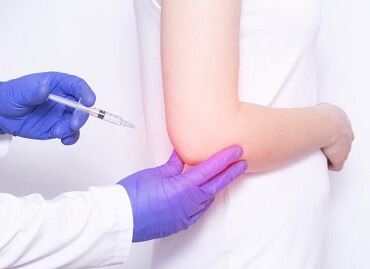
If triceps tendonitis symptoms fail to improve after two weeks of rest, ice and medication, then your doctor may advise a corticosteroid injection.
This is where the area is injected with a mix of steroid and analgesia to reduce the inflammation and pain. Your doctor may opt to give the injection in one of two ways:
- Directly into the triceps brachii tendon: this gets the corticosteroid mix straight to the problem area but does run the risk of weakening the tendon
- Into the surrounding area: the corticosteroid is injected in a few different places surrounding the tendon so as to bathe the area without the risk of further tendon damage
Corticosteroid injections for triceps tendinopathy are most effective when given within the first three months of symptoms. You should never have more than 2 injections to the same site in 1 year, and ideally the area should not be injected more than 3 times over any period. This is to reduce the risk of further damage due to tendon weakening.
5. Physical Therapy
Physical therapy is often advised with triceps tendonitis not only to help with healing, but also to prevent recurrence of triceps tendonitis. As well as treating the client’s triceps tendonitis symptoms, they will also address any underlying causes of the condition such as muscle weakness or tightness.
Physical therapy for weightlifters elbow may consist of:
- Triceps Tendonitis Exercises: Stretching and strengthening exercises will help you regain full strength, length, flexibility and endurance in the triceps brachii. The muscle will be weak following triceps tendon injury so it is really important to rehab it fully to prevent further injury or the recurrence of tendonitis
- Ultrasound or Laser Treatment: These modalities can help to reduce pain and inflammation from triceps tendonitis and help to realigning collagen fibers as the tendon heals to ensure it regains full strength and flexibility
- Taping: Taping can be helpful when returning to sports after triceps tendonitis to reduce the forces going through tendon
- Triceps Tendonitis Brace: Another option when returning to sports or manual work is to use a triceps tendonitis brace or strap. These help to support the elbow area and reduce the tension through the tendon so it is less likely to experience further damage.
6. PRP Injections
If your symptoms have failed to settle after three months of using the triceps tendonitis treatments we have already discussed, then your doctor may recommend a PRP injection – platelet rich plasma injection.
Plasma contains special proteins that support cell growth and help the blood to clot. Injecting platelet rich plasma into the damage triceps tendon is thought to stimulate your body to produce new, healthy cells that help with the healing process.
A small amount of your own blood is taken and placed in a centrifuge which spins the blood extremely fast for around 15 minutes. This causes the different components in the blood to separate. The plasma is removed and can then be injected directly into the damaged tendon under ultrasound guidance to ensure it reaches the correct place.
More research is needed looking into the effectiveness of PRP injections but they are becoming increasing popular in the treatment of tendon damage, particularly amongst elite athletes. At present, most insurance companies will not cover the costs of PRP treatment which can come in around $1000 as it is not FDA approved.
7. Activity Modification
If your weightlifters elbow was due to sport, it is worth working with a specialist trainer/coach to ensure your training technique is correct. They may suggest modifications to your training schedule or even your technique e.g. tennis serve if that is thought to have been a contributing factor to your triceps tendonitis.
Surgery For Triceps Tendon Injury
In most cases, non-surgical triceps tendonitis treatment will be sufficient, but if symptoms fail to settle or there is more serious tendon damage e.g. severe tear or rupture of the triceps tendon, then surgery may be necessary.
There are two options when it comes to triceps tendonitis surgery:
- Triceps Tendon Repair: The torn section of tendon is repaired with stitches and then attached securely to the olecranon at the elbow
- Triceps Graft: If the damage to the triceps brachii tendon can’t be repaired then the damaged section of tendon is removed and replaced with a length of tendon taken from elsewhere in the body.
After a triceps tendon repair or graft, the elbow is immobilised for a few weeks in a splint or brace. You will then work with a physical therapist on a rehab program to regain full range, motion and strength in the triceps muscles and the elbow joint.
It can take up to 6 months to fully recover from triceps tendonitis surgery.
Triceps Tendonitis Recovery Time
Triceps tendonitis recovery time will vary depending on the severity of the problem and how long you have had it for.
- Mild Triceps Tendonitis: typically has a short recovery time of a few days to a few weeks with the right combination of rest, ice and medication
- Moderate Triceps Tendonitis: recovery time will usually be around 2-4 months and involve rest, ice, medication, physical therapy and possibly injections
- Severe Triceps Tendonitis: recovery time may be 6-12 months, particularly if you need surgery
The good news is, most people make a full recovery from triceps tendonitis in time and get back to doing the things they love.
Triceps Tendonitis Summary
Triceps tendonitis is a common cause of upper arm pain and posterior elbow pain.
It is caused by damage and inflammation in the triceps tendon on the back of the upper arm, usually due to overuse.
Common activities that result in weightlifter's elbow include sports involving lots of elbow extension e.g. gymnatics and throwing sports, DIY and workout exercises e.g. press ups
Triceps tendonitis causes pain and tenderness at the back of the elbow and may be accompanied by a popping or snapping noise when you move your arm. There may also be some swelling and stiffness.
Another common cause of pain at the back of the elbow is olecranon bursitis - inflammation of the bursa that sits over the pointy bone at the elbow.
Treatment for triceps tendonitis starts with avoiding aggravating activities as much as possible to give the tendon time to heal and using ice and medication to control the pain and inflammation. As things start to improve you can start doing strengthening and stretching exercises to regain full strength and mobility.
Physical therapy, injections and in some cases surgery may be recommended.
You may also be interested in the following articles
- Elbow Pain Diagnosis Charts
- Pain Behind The Elbow
- Inner Elbow Pain
- Outer Elbow Pain
- Upper Arm Pain
- Arm Strengthening Exercises
- Arm Nerve Pain
Related Articles
Page Last Updated: May 21st, 2024
Next Review Due: May 21st, 2026

